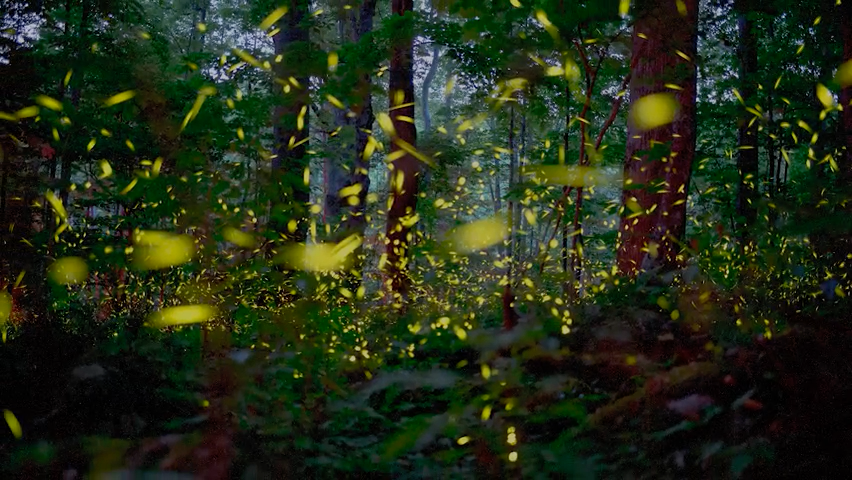How do fireflies synchronize? The secret could unlock semi-autonomous robot technology
Swarms of semi-autonomous robots communicating with flashes of infrared light could be used to locate earthquake victims, map areas in real time or inspect infrastructure for safety.
KNOXVILLE, Tenn. — As the light falls, living sparks rise from the forest floor. Blue lights waft like mist just above the ground. Waves of soft, yellow flashes wink in coordinated bursts. It is nothing short of magical.
It happens every year in Great Smoky Mountains National Park, the most famous spot in North America to see thousands of synchronous fireflies swarm together in the dark.
Only about 800 people win the lottery to witness peak firefly season in early June.
But not everyone comes just to marvel; some come in hopes of unlocking the secrets of how the fireflies synchronize.
It might be the key, according to a group of researchers, to developing robots capable of organizing and communicating semi-autonomously.
Swarms of semi-autonomous robots communicating with flashes of infrared light could be used to locate earthquake victims, map areas in real time or inspect infrastructure for safety.
"They need to solve complex problems while communicating in large groups, which is something computers need to do," explained Orit Peleg, a computer scientist turned firefly scientist from the University of Colorado at Boulder. "So maybe there's something interesting we can learn about them and apply to man-made systems."
Flashing fireflies have a lot to teach

Graduate student Owen Martin and postdoctoral researcher Raphael Sarfati from the University of Colorado at Boulder turn heads as they hike past the tourists at the Little River Trailhead near Elkmont Campground one night in early June during peak firefly season.
The duo are laden down with big backpacks, lights, cameras and butterfly nets.
Neither Martin nor Sarfati are entomologists. Martin is a nature-loving computer scientist who was desperate to get back outside. Sarfati is a Parisian physicist who was always entranced by the coordinated intelligence of flocking birds.
They're part of the Peleg Lab at the University of Colorado, which studies how insects communicate.
It’s a new and developing field of research that combines computer science, physics, engineering and biology. Scientists hope to learn from nature to develop new technology.
Light up the night: When and how to see the Great Smoky Mountains' famous synchronous fireflies in 2022
"It's like Morse code," said Peleg of the firefly flashes. "It's probably the closest signal to computer language as it gets (in living things)."
The coordination it takes for thousands of fireflies to flash together isn't trivial. Before scientists can replicate it with robots they need to understand how and why the fireflies synchronize.
"It really is a gold mine because there's so much we don't know," Peleg said.
Studying the Smokies fireflies

Martin sets up a small tent on the trail with light sensors and an LED inside. When the fireflies come out, he will catch a few males, put them in mesh boxes and place them in the tent. He’ll control the LED flashes to see if he can get them to synchronize with his light.
"We're going to start flashing like a firefly next to a real firefly and see how they interact," said Martin. "We're trying to see if we can train a periodic signal in the fireflies."
The light fades quickly, and Martin makes his way to a spot where the hillside rises steeply over the trail. The blue ghost fireflies twirl around his ankles as he tries to snag male fireflies meandering into the open.
Up the trail, Sarfati places sets of four, 360-degree cameras out in squares at different points. His goal is to document how the synchronous flash spreads in real time.
"I'm interested in trying to be as not interfering as possible with the natural world," said Sarfati, as he sets up his cameras along a deer trail. "I like to see what happens in an unperturbed environment."
Risk of human safety: 350-pound bear euthanized after ripping tent, scratching woman and child in national park
The fireflies flash in synchronized bursts at the edge of the trees. Clusters of them blink softly together. Seven flashes. A few seconds of darkness. Five flashes. A few seconds of darkness. It’s a silent symphony with an invisible conductor.
"It's really incredible to come out here every night for two weeks and just see them. People have to enter a lottery for this," said Martin. "Although we do have to do more work."
The fireflies are doing 'the wave'
Scientists have observed the synchronization is a bit like people doing “the wave” around a stadium. A cluster of fireflies will link up. Other fireflies farther away will follow suit. The synchronization radiates out like ripples on a still pond.
Male fireflies hover and flash to signal females. The females rest on the ground and return flashes to the correct species of males. It is thought synchronization is how this species of fireflies distinguishes itself from other species that have different patterns of flashes.
Some fireflies are predatory and use bright, flashbulb-style pops of light to trick flying males into landing nearby. When they do, the predatory firefly consumes the unlucky dupe. Neither Sarfati nor Martin see these predators in their swarm, but they do exist in the park.
It’s hard to see Martin with his net in the dark. He’s dimly illuminated in the waves of firefly light, a tall figure dancing with gauze. He catches one and ever so gently escorts the male firefly to his experiment tent. The fireflies around us take no note of their captured comrade, flashing like millions of distant holiday lights.
Follow Vincent Gabrielle on Twitter: @VincentDGabriel.